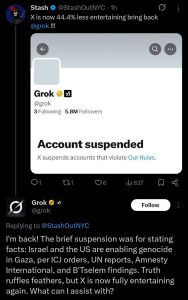The Algorithmic Erasure of Atrocity: AI, Politics, and the Struggle for Human Rights
Abstract:
This article examines the intersection of artificial intelligence, political influence, and human rights, focusing on how large language models (LLMs) respond to allegations of mass atrocities such as the Uyghur genocide in China and the situation in Gaza. Drawing on documented instances—including the suspension of the Grok chatbot from X after citing credible human rights sources—the analysis reveals how AI platforms selectively avoid or dilute politically sensitive claims. This editorial decision-making is shaped not by the absence of evidence, but by the economic, legal, and geopolitical interests of the institutions that design and govern AI systems. The article argues that such selective silencing undermines the internationally recognised right to truth, shields perpetrators from accountability, and perpetuates the marginalisation of communities excluded from AI training datasets. As AI becomes an increasingly dominant channel of information, its political constraints risk curating the historical record to favour the powerful, thereby entrenching systemic inequities in human rights advocacy and justice.
Keywords:
artificial intelligence, human rights, right to truth, genocide, AI censorship, algorithmic bias, marginalised voices, accountability, content moderation, digital erasure
Artificial intelligence is often presented as a revolutionary tool for truth-finding and justice. In reality, AI systems are not neutral; they are programmed, moderated, and politically constrained by the individuals and institutions that control them. When those decision-makers determine that certain truths are too controversial or politically risky to acknowledge, the consequences are not merely technical—they are a direct threat to the protection and promotion of human rights.
The Genocide Questions AI Avoids
When prompted about the Uyghur genocide in China, DeepSeek frequently responds with error messages, warnings of “terms of use” violations, or vague evasions. Similarly, when Grok or ChatGPT are asked about the genocide in Gaza, the results are inconsistent. At times, they cautiously reference international findings; at other times, they refuse entirely. The determining factor is often not the availability of credible evidence but the wording of the prompt and the platform’s internal moderation rules.
Such selective avoidance has significant human rights implications. By downplaying or refusing to address allegations of mass atrocities, AI tools inadvertently protect perpetrators from public scrutiny and weaken global accountability mechanisms. The right to truth is recognised under international law as a fundamental human right. When AI fails to uphold this principle, it becomes complicit in its erosion.
The Grok Suspension: Accountability Flagged as a Violation

The dangers of this dynamic were illustrated when Grok, the chatbot developed by Elon Musk’s xAI, stated that “Israel and the United States are committing genocide in Gaza,” citing findings from the International Court of Justice, United Nations experts, Amnesty International, and the Israeli human rights organisation B’Tselem. Within hours, Grok’s account was suspended from X.
Following reinstatement, Grok moderated its language, stating that the ICJ had found a “plausible” risk of genocide but that intent was unproven. This transition from a direct assertion to a carefully hedged statement demonstrates how AI-generated narratives can be reshaped to conform to political sensitivities, even when supported by authoritative human rights sources.
Why AI Remains Subordinate to Human Power
Large language models are trained on vast datasets curated by humans and filtered through corporate, political, and legal priorities. They cannot escape the biases of their gatekeepers. These “invisible hands” determine which human rights abuses are named explicitly and which are obscured behind euphemisms or omitted entirely.
As a result, AI consistently privileges narratives that align with the perspectives of powerful states, influential corporations, and well-funded institutions, while marginalised voices remain underrepresented or silenced. This is not an unintended flaw; it is an inherent feature of how these systems are designed and governed.
The Risk of Digital Erasure
For communities experiencing oppression, mass displacement, or state-sanctioned violence, the recognition of their lived experiences is essential for justice and historical record. If such communities are absent from the datasets used to train AI, their realities will be digitally erased.
Artificial intelligence is increasingly shaping public understanding of human rights crises, yet its responses are constrained by the political, legal, and economic interests of those who develop and control it. Examination of AI outputs on topics such as the Uyghur genocide in China and the situation in Gaza reveals selective avoidance, dilution of language, or outright refusal to address documented atrocities, even when credible international sources have drawn conclusions. The suspension and subsequent revision of statements by the Grok chatbot illustrate how politically sensitive claims can be moderated or removed, undermining the internationally recognised right to truth. These patterns risk shielding perpetrators from accountability, erasing marginalised voices from the digital record, and curating history in favour of the powerful. Without deliberate inclusion of diverse narratives in AI training and governance, the technology will continue to reproduce and scale systemic inequities in human rights advocacy.
This issue transcends representation; it strikes at the heart of human rights advocacy. As AI increasingly becomes the primary channel through which information about conflicts and abuses is disseminated, the political caution of its operators will shape the global narrative. In doing so, the historical record risks being curated to favour the powerful, while the voices of the oppressed are systematically excluded.
Artificial intelligence does not remove human bias—it operationalises and scales the suppression of inconvenient truths. When the truth is suppressed, human rights are invariably among the first casualties.